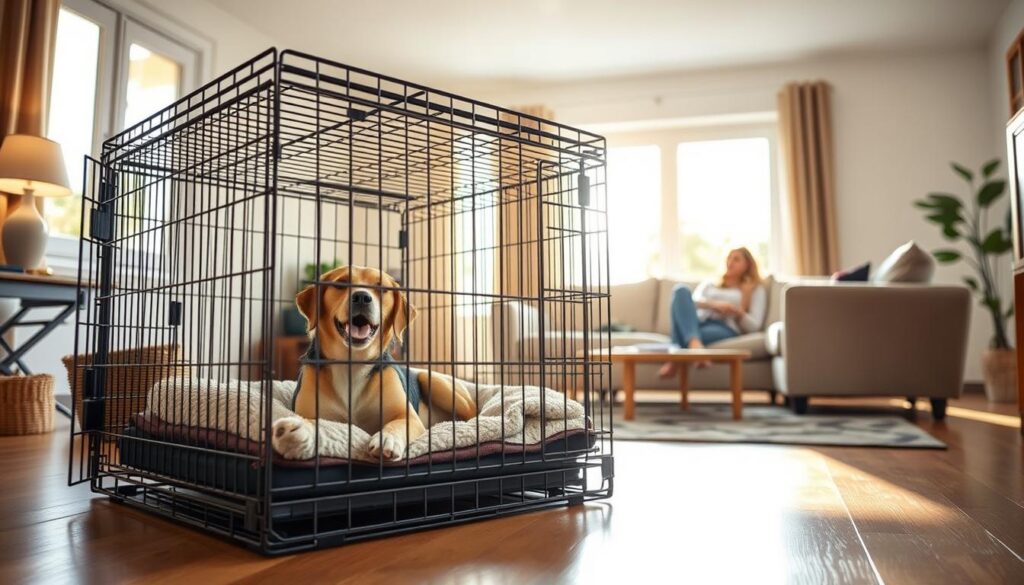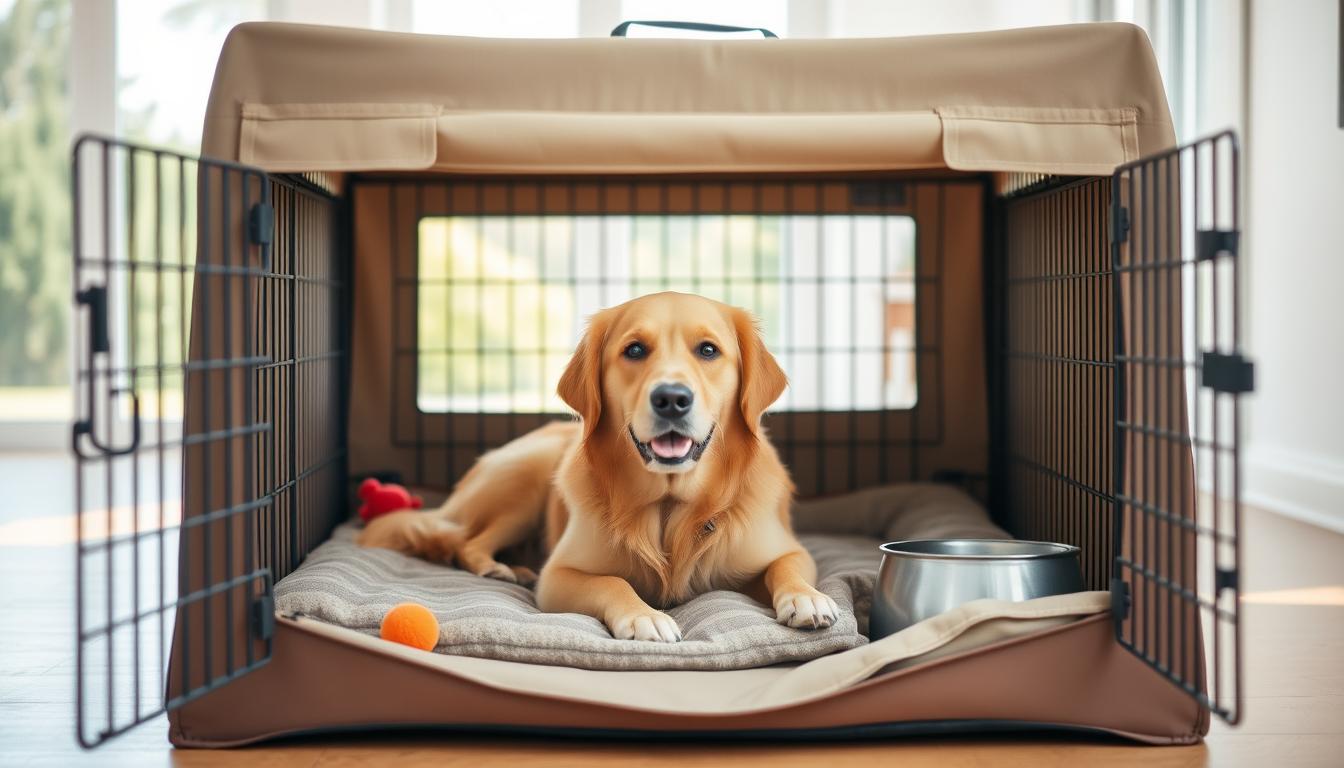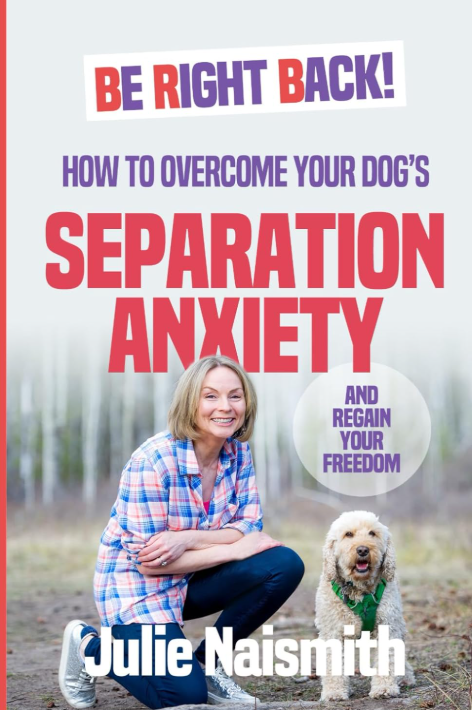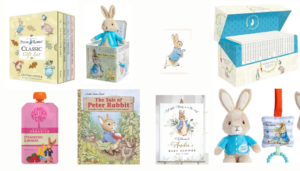Welcome to our complete guide on how to kennel train a dog! We will help you create a safe and cozy space for your furry friend. Our guide is here to explain why kennel training is key, its benefits, and how to do it right. Together, we’ll make sure your dog loves their crate. Kennel Training Your Dog!

Key Takeaways
- Learn how to kennel train your dog effectively and lovingly.
- Understand the benefits of crate training for your dog’s well-being.
- Select the right crate that suits your dog’s size and needs.
- Establish a routine to make crate training an enjoyable experience.
- Utilize positive reinforcement for successful training outcomes.
- Address common challenges during the kennel training process.
Introduction to Kennel Training Your Dog
Welcoming a dog into our lives is a rewarding experience! As responsible pet owners, we must understand the foundational aspects of kennel training. This journey begins with an introduction to kennel training, where we create a safe and comfortable environment for our furry friends. A crate is more than just a confined space; it’s a cozy haven that offers security during uncertain times.
The dog crate training benefits are abundant. A crate serves as a safe place during travels, ensuring our pets feel secure. It aids in potty training, gradually helping our dogs learn where to relieve themselves. This practice not only reduces anxiety but also fosters a sense of trust in their surroundings, asserting that home is a safe zone. Embracing kennel training is an exciting opportunity for us to strengthen the bond with our dogs!

Benefits of Dog Crate Training
Many pet owners find that crate training makes their dogs feel safe and secure. It creates a cozy space that feels like a den. This is very helpful during stressful times like vet visits or car rides.
Crates are also great for housebreaking. Dogs don’t like to mess where they sleep. So, a crate helps them learn to go outside when they need to.
Using a crate can also help dogs feel less anxious when left alone. It stops them from getting into trouble. Crate training teaches good habits and helps dogs adjust to new situations.

How to Choose the Right Crate for Kennel Training Your Dog
Choosing the right crate for your dog can be tough with so many choices! Let’s look at the different types of dog crates and what to consider. Every dog is unique, so it’s key to know the differences in crate styles. This helps find the best crate for your furry friend.
Types of Dog Crates, Kennel Training Your Dog
There are a few popular types of dog crates, each with its features and benefits:
- Plastic Crates: These are light and great for travel. They offer a cozy space for your dog, making them feel safe.
- Wire Crates: These have a strong metal frame, providing good visibility and air flow. They’re perfect for training and home use!
- Soft-Sided Crates: Ideal for indoor use or travel, these are light and easy to carry. But, they might not be good for dogs that chew a lot.
Factors to Consider When Choosing a Crate
When picking the right crate for your dog, think about these factors:
- Size: Make sure the crate is big enough for your dog to stand, turn, and lie down comfortably.
- Durability: If your dog likes to chew, choose a crate made from strong materials that can handle their chewing.
- Dog’s Temperament: Think about whether your dog is anxious or calm. Some dogs need a closed space, while others prefer open areas.
- Ease of Cleaning: Pick a crate that’s easy to clean. Accidents can happen, and they’re more common when training!
Finding the perfect crate is all about your dog’s comfort and safety. Look at the options carefully to make sure you pick the right one for your furry friend!
How to Kennel Train a Dog: Step-by-Step Process
Are you ready to start kennel training your dog? We’re here to guide you through it. This step-by-step guide will make the transition smooth for both you and your dog.
Setting Up the Crate
First, let’s set up the crate. Place it in a quiet, calm spot. It should be away from busy areas to avoid distractions. Add soft bedding and a few favorite toys to make it cozy.
Introducing Your Dog to the Crate
Now, it’s time to introduce your dog to their new home. Encourage them to explore at their own pace. Use treats to make it a positive experience. Start by tossing a treat inside for them to get.
As they get more comfortable, you can keep the door open for longer. This helps build trust and comfort. Remember, this is all part of the kennel training process!
Establishing a Crate Training Schedule
Now that we’ve introduced the crate, it’s time to focus on establishing a crate training schedule! A consistent routine is key for your dog’s comfort and security. It should match their natural behaviors and needs, helping them relax when needed.
Developing a Consistent Routine
To help your furry friend adjust to crate training, we need a structured routine. Here are some crate training schedule tips:
- Morning Routine: Start the day with bathroom breaks and playtime before crate time.
- Mealtime: Feed your dog outside the crate, then give them crate time to learn it’s safe.
- Midday Breaks: Try to fit in some crate time during lunch, letting them unwind while you work.
- Evening Wind-down: End the day with play, then crate time to get ready for bed.
Incorporating Crate Time into Daily Life: Kennel Training Your Dog
Our lives can get busy, but adding crate time to our daily routine is doable and good for our pets! Here’s how to make it work:
- Make the crate cozy with a blanket and favorite toy, inviting your dog to relax.
- Use crate time as a chance for your pup to recharge when you have visitors or during family meals.
- Introduce short crate sessions when you’re home, gradually increasing duration to enhance their comfort.
Effective Kennel Training Techniques: Kennel Training Your Dog
Kennel training is an excellent journey for you and your dog. We’ll explore effective techniques that make the kennel a positive place. Positive reinforcement is key, making the crate a safe and cozy spot for your dog. Treats and praise when they enter the crate make them excited to do it again!
Positive Reinforcement Methods
Positive reinforcement rewards good behavior. It turns the crate into a safe space for your dog. Here are some ways to do it:
- Give treats every time your dog goes into the crate willingly.
- Place a favorite toy or blanket inside for a cozy feel.
- Verbal praise like “Good boy!” boosts their confidence.
- Gradually increase crate time with rewards for calmness.
Avoiding Common Training Pitfalls
As we start training, it’s essential to avoid common mistakes. Here are some to watch out for:
- Never punish your dog for whining or barking, as it can increase anxiety.
- Avoid forcing your dog into the crate, as this can create a negative association.
- It’s essential not to leave your dog crated for extended periods; they need exercise and social interaction.
Crate Training Problems and Solutions
Crate training can have its challenges, but it’s normal. Many pet owners face crate training problems, like separation anxiety. With the right approach, we can turn these challenges into manageable tasks. Let’s explore effective solutions!
Diamond Dog Food: Is It a Healthy Choice for Your Dog?
Dealing with Separation Anxiety
Separation anxiety is a big issue for many dogs during crate training. Recognizing signs like barking, whining, or destructive behavior helps us know when they’re anxious. To ease these feelings, we can use gradual exposure techniques. Here’s how:
- Start by leaving your dog in the crate for short periods, gradually increasing the time.
- Make the crate inviting with cozy bedding, toys, and treats.
- Practice positive reinforcement by rewarding calm behavior when your dog is inside the crate.
Addressing Reluctance to Enter the Crate
Some dogs are hesitant to enter the crate, which can be frustrating. But we can make it simple and fun. Here are a few strategies to encourage your pup to enter the crate:
- Use treats! Toss a few tasty morsels inside the crate and allow your dog to explore.
- Play games that involve the crate, turning it into a fun space.
- Use gentle encouragement, like leaning in with a happy voice, to make your dog feel secure.
By focusing on these methods, we can overcome common crate training problems. We can create a positive environment for our pets. Training takes patience, but the bond we create with our dogs is advantageous!
Crate Training Tips for Success
For a successful crate training, we need a few key tips. These tips focus on our pets’ comfort. Watching how they adjust to the crate is essential.
Monitoring Your Dog’s Comfort
Keeping an eye on your dog’s comfort is critical. Ensure the crate has good air flow, is the right size, and has comfy bedding. Watch their behavior in the crate closely. If they seem stressed or uncomfortable, it’s time to make some changes.
Adjusting Crate Training Techniques as Needed
As crate training goes on, we might need to tweak our methods. Every dog is different, and what works for one might not work for another. If you hit a snag, try different approaches. For instance, you could start with small steps, increase crate time gradually, or use different treats.
By monitoring and adjusting, we can make crate training a positive experience for our dogs. This connection with our pets makes the learning process loving and supportive. Let’s enjoy this journey together!
Best Practices for Kennel Training Your Dog
We’ve gathered key practices for kennel training to make it fun for you and your dog. These strategies create a supportive space for learning and growth. Let’s explore how to keep things consistent and ensure a positive crate training experience for your dog!
Maintaining Consistency During Training
Consistency is key in kennel training. A reliable routine helps your dog know when it’s time for the crate. Here are some tips to keep things steady:
- Set specific times for crate sessions, making sure to stick to the schedule.
- Use the same commands and phrases when it’s time for crate training.
- Reward your dog promptly after they enter the crate correctly.
By following these tips, we can make the transition smoother for our furry friends!
Using Crate Training as a Positive Experience: Kennel Training Your Dog
Creating a positive crate training experience is vital. Our dogs should see their crate as a safe space, not a prison. Here’s how to make that happen:
- Use treats, toys, and praise to encourage your dog to enter the crate willingly.
- Gradually increase the amount of time spent in the crate, ensuring they feel comfortable.
- Stay calm and reassuring during training sessions to help alleviate any anxiety.
By using these methods, we can create a joyful environment where our pets thrive. Let’s work together to connect with our dogs and make crate training an enriching experience!
Conclusion
As we finish our guide on how to kennel train a dog, let’s look back at our journey! We covered the benefits of crate training, how to pick the right crate, and the best techniques. This guide has given us the tools to help our dogs succeed!
Remember, every dog is different, and training takes time and understanding. With patience and love, we can create a safe and happy space for them. We learned the importance of a consistent routine and positive reinforcement in crate training.
Let’s continue this incredible journey together and celebrate our progress with our pets! Happy training, and may your efforts strengthen your bond with your dog!
FAQ
What is the best way to kennel train my dog?
To kennel train your dog well, make the crate a positive place. Start with short times, use treats and praise, and slowly increase the time. A regular crate training schedule is key!
What are some crate training tips for success?
For crate training success, ensure your dog is comfortable with cozy bedding. Keep the crate in a quiet spot and watch your dog’s reactions. Use positive reinforcement and adjust as needed!
How do I choose the right crate for my dog?
Choose a crate that fits your dog’s size and personality. There are many types, like plastic, wire, and soft-sided crates. Make sure it’s big enough for your dog to move around and lie down!
What should I do if my dog has separation anxiety during crate training?
For separation anxiety, start with short crate times while you’re nearby. Use treats to make the crate a safe space. This helps build positive feelings!
How can I deal with my dog’s reluctance to enter the crate?
To get your dog to enter the crate, use treats and toys. Try feeding them inside the crate to make it a positive place. Be patient and use positive reinforcement!
What are the common crate training problems?
Common problems include barking, not wanting to enter, and accidents. Keep a consistent training schedule, ensure comfort, and build positive experiences!
How long should I keep my dog in the crate?
Crate time varies by age and training. Puppies shouldn’t be crated for too long, while adult dogs can handle it. Always think about your dog’s comfort!
What should I include in my crate training schedule?
Your schedule should include potty breaks, meals, playtime, and crate time. Consistency helps your dog feel secure in their crate!
How can I make crate training a positive experience?
Make crate training positive with treats, toys, and praise. Make the crate a cozy den, not a punishment. Create a welcoming atmosphere and routine!







